During the month of December 2010, the available data was fed into the system to analyze the various reports generated and the different information that it can store. Currently, the Waste Data Collection System analyzes different types of waste, tonnages of the wastes, Kilometers of street swept, and identifies various assets where the waste is transferred or disposed such as the transfer station and the landfill.
The CMS Team does not have the authority to verify the data provided to the center by the Landfill and Transfer station operator, therefore the figures mentioned in this section are as reported. The CMS Team is working with the Landfill and Transfer Station Operator to improve the quality of data being input into the MCS. Figure 4.5 shows the Waste data page on the MCS.
The analysis and interpretation of the data fall under each of the charts given below. The interpretation is given with a view that CMS (company) will continue its operation beyond the month of December. Moreover, it is only intended to facilitate better management of the team in the future. It will also assist the team while strategizing and planning. It is also written to enable the team to focus and concentrate its resources towards the most profitable and promising areas. It is also worthwhile to note that this analysis is solely intended to facilitate continuance of the CMS team. The analysis and interpretation brings into light the many factors that affect waste collection. This will help CMS to understand and interpret data availed to them deeper and better than before.
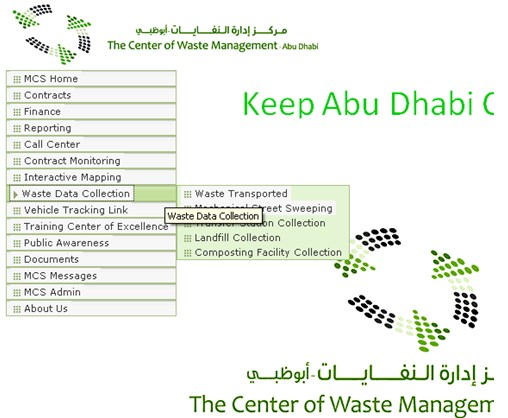
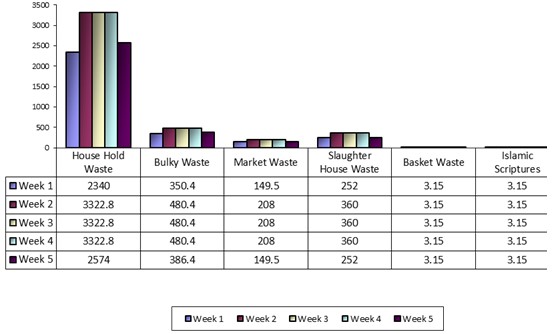
The dispersion of tonnages of waste collected by lot 1 were as follows , 72% house hold waste,13% Bulky waste, 5% Market waste, 9% slaughter house waste, basket waste and Islamic waste averaged less than 1% of the total 17282.3 tons of wastes collected during the month. It is evident that the amount of waste collected in the second to through the fourth week of the month remained constant at 4375 tons. The festivities in the middle of weeks the month December explain this sharp increase. The largest size of waste in areas visited and serviced by lot 1 were household waste. Markets places were also very busy in the middle weeks of the month evidenced by the increase in market waste from 149.5 tons to 208 tons over the second to the fourth week, thus wastes are seasonal and follows events. Basket wastes and Islamic scriptures waste were the same from the first to the fifth week. Bulky waste may have increased probably due to increased production of fast consumer in industries. The festivities also influenced the increase in slaughter house waste, this implies that the amount of meat consumed over the middle three weeks rose, resulting to the increase.
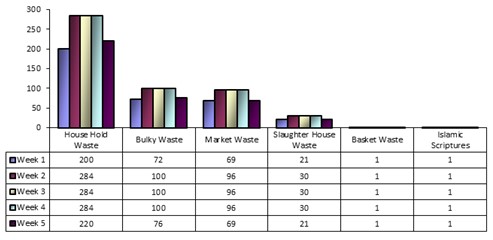
Figure 4.6 and Table 4.7 are the tonnages and trip of waste collected in Lot 1 in the month of December 2010.
During the month of December 2010 the trips undertaken to correct Household waste contributed more than 55 % , Bulky waste 20%, market waste 19%, slaughter house waste 6 % while basket waste and Islamic scriptures contributed to under 5 % of the total trips undertaken during the month of December. The trips made to collect various wastes were evenly distributed with the mode of trips being 284 for house hold waste, 100 for bulky waste, 96 for market waste, 30 for slaughter house waste and 1 trip per week for basket waste and Islamic scriptures respectively. This implies that there were more trips undertaken towards collection of house hold waste mainly due to the fact that December is month of festivities. On the other hand, this implies more than half of transport costs attributed to lot 1 were constituted mostly by house hold waste. These big differences may have been brought about by the fact that there is high frequency of waste among house holds since they have chores like cooking and washing which have to be undertaken often unlike basket waste, market waste that which occurs occasionally as opposed to rarely. There are no or few basket waste and Islamic waste in the regions covered by this lot. As a result few transportation costs were attributed to these wastes.
Figure 4.8 and Table 4.9 are the tonnages and trip of waste collected in Lot 2 in the month of December 2010.
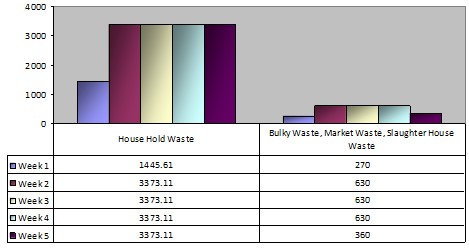
The total tons of waste collected by lot 2 were 17457.94 tons, whereby 86% of the total tonnages collected which amounts to 14937 tons while the other types of waste contributed 14 % of the wastes. The mode for tons collected relating to house hold wastes were 3373.5 tons, and that of the other wastes were 630 tons a week. Clearly these areas have more of house hold waste than the other types of wastes this is because week in week out they exceed the other types by more than five times in total.
This may have been because of the nature of the living styles, their beliefs and political and religious influences. This implies that the areas serviced by this lot probably are residential and there are no big markets and industries. The highest number of staff should be made available and assigned in the collection of household wastes to facilitate effective and efficient waste collection. It is likely that due to the nature of portability of household wastes and the easiness to dispose may be the causes of the high tons were collected unlike the bulk wastes. Thus, because of the nature of the type of waste being disposed it may create a challenge on the collecting and disposing team.
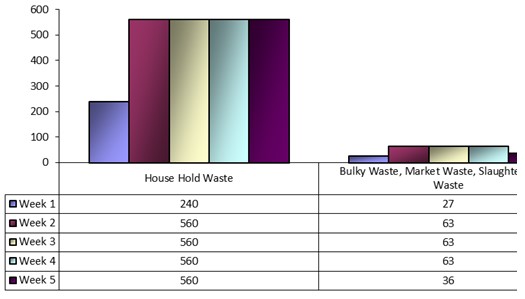
Trips taken by lot two were evenly distributed with trips for household waste averaging to 560 trips a week while the rest had mode of 63 trips per week. The mode for trips during the month was 623 trips. The total trips undertaken towards waste collection were 2732, of which 91 % that is 2480 of them were for collection of House hold wastes, and the rest were for the other types of waste which were 252 in total. This is brought about by the specialization of the vehicles in use towards certain forms of wastes and the nature of waste being collected. This implies that there is a hindrance and a barrier towards the mode and means of transport that can be used to dispose and collect the wastes.
The total cost of carrying or transportation costs were attributed to household wastes. CMS should look in investing more of its capacities towards household waste since it is the number one source of income and again in expenditures. It is again worthy to note that waste are affected by seasons since in the month of December during the festive weeks there are increases in trips which consequently translates to large sizes of wastes. This increase in house hold wastes again is attributable to the fact the life style during this period is lavish and extravagant. Thus the high volumes of house hold wastes compared to the other wastes.
Charts 4.10 and 4.11 are the trips of waste collected Vehicle and Area wise in Lot 3 in the month of December 2010.
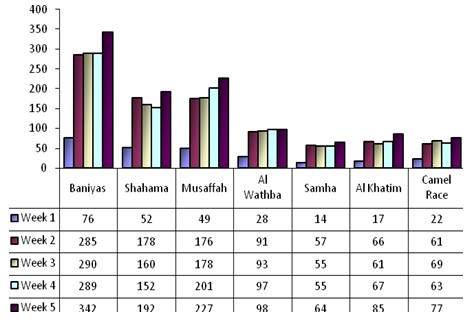
Lot three undertook their waste collection in seven areas which were Baniyas, Shahama, Musaffah, Al Wathba, Samha, Al Khatim, and Camel Race. They undertook 4087 trips during their duties of which 68 % were for Baniyas, 18% Shahama, 20 % Musaffah, 10 % Al Wathba, , 6% Samha, 7 % for Al Khatim and Camel Race respectively. Baniyas is the dirtiest areas among those cleaned by lot three, followed by Musaffah, Shahama, Al Wathba, Al Khatim and Samha respectively. It is also important to note that, distances, accessibility of an area, lifestyles, population sizes are some of the factors that may have influenced the differences noticed in the trips taken to different areas.
There is also a sharp increase in waste during the middle weeks as noted in the other lots data.this goes to show that waste collection are affected by seasons, probably if it were on a month of no feastivities like January we would not have seen this increase. The company should assign a large number of staff of lot 3 to Baniyas this is necessitated by the trips taken to collect waste in this area. This reflects that there are larger sizes of waste to be collected in this area, which can be attributed probably to the area population structure and infrastructure accessibility. The biggest shares of costs of transport allocated to lot 3 were applied in collecting wastes in Baniyas. It is also imperative for the team to take into consideration the above in staff allocation, expenditure budgeting in future.
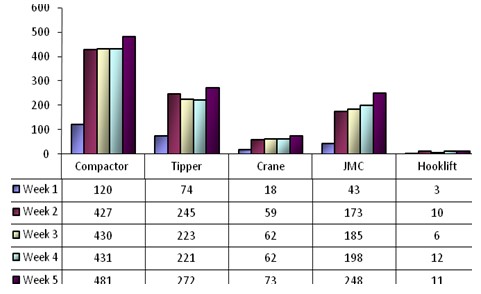
There are five vehicles in use by lot 3 which are Compactor, Tipper, Crane, JMC, and Hook lift. Vehicle usage in the month rated according to the trips undertaken during the month were as indicated below, compactor took 1889 trips, Tipper 1074 trips, crane 274 trips , JMC 847 trips and finally Hook lift which took only 11 trips. In total there were 4087 vehicle trips. The compactor was the most active vehicle in the month with 46 % of the total vehicle trips in the month followed closely by Tipper with 25% while the rest of the vehicles took less than 10 % combined. Hook lift is the most underutilized vehicle by the lot, while compactor is the over utilized vehicle. This difference in usage may be due to the compatibly in terms of specifications in usage and capacity of the vehicle in undertaking the tasks.
The expenses incurred on compactor and tipper mainly increased transportation and fuel costs relating to the group. More of vehicle maintenance costs should have or in future be directed towards maintenance of the compactor, and this vehicle together with the tipper should be serviced more often. This is to prevent any go-slow in case they broke down and they are the main vehicles in operation. Moreover, a higher depreciation charge should be attributed to the two vehicles. The company should also consider quality and reliability while purchasing a new compactor and tipper. As noted above there are still increases in trips during the festive weeks at the middle of the month.
Charts 4.12 and 4.13 are the tonnages of waste collected Vehicle and Area wise in Lot 4 in the month of December 2010.
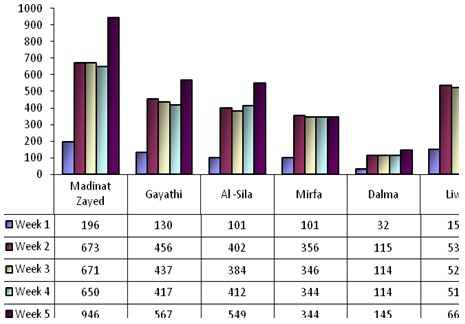
They undertook their waste collection in Madinat Zayed, Gayathi, Al-Sila, Marfa, Dalma and Liwa. They collected 11403 tons of waste of which 28% was of Madinat Zayed, , 17 % Gayathi, 16 % Al-Sila, 13 % Marfa, 4 % Dalma and 2 % Liwa. The group was more active during the fifth week in which they collected 3220 tons of waste collectively in all the areas, and were not very active during the first week. Liwa is likely to be the least populated area followed by Dalma, Marfa, Al-Sila, Gayathi and Madinat Zayed respectively. As witnessed in the other lots data there is still the increase from week two through week five. Madinat Zayed is the dirtiest area and most of the staff of lot 5 to this area since it is the most populated and has the largest size of wastes. Furthermore, it is also likely that the areas with the least tons of waste collection may probably have been caused by longer distances from the disposing sites. In addition, most likely the areas may have been in accessible.
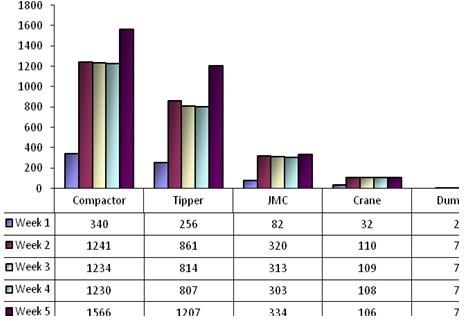
The lot used four vehicles Compactor, Tipper, JMC, Crane, and Dumper to facilitate smooth performance of the assigned duties. The total tons of waste collected by the lot totaled to 11404 tons. The vehicle usage in terms of tonnages loaded were as follows 5611 tons Compactor, 3945 tons Tipper, 1352 tons JMC, 467 tons Crane, and 30 tons for Dumper. Thus compactor facilitated almost 50 % of the group’s tasks as compared to 34 % of Tipper, 12 % JMC, 4 % Crane and less than one percent of Dumper. This is an indicator of how the team consider mode of transport and vehicles in waste transportation. Again the dumper may have been underutilized since it is not designed for such types of wastes. The vehicle usage should indicate the costs of depreciation, vehicle maintenance and fuel costs.
Chart 4.14 and Table 4.15 are the tonnages and trips of waste collected in Lot 5 in the month of December 2010.
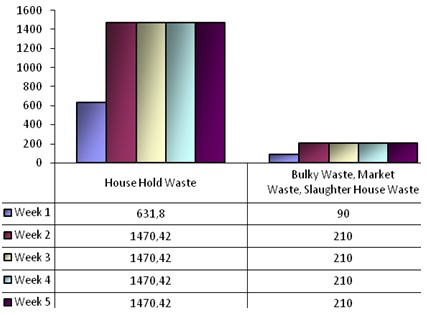
The number of tons collected by lot three was 7443.48 during the month of December. House hold waste still was the largest in size in the areas covered by lot 5. This amounted to 87 % of the total 7443.48 tons collected, and only 13 % of it, was attributed to the other wastes collectively. The total waste tons collected over the weeks were 721.8 tons the first week, 1680.42 tons for the second, third and fourth week and finally the fifth week respectively. The average size of waste in terms of tons collected were 1680 tons for house hold wastes and 210 tons for the other wastes. As noted above the increase in middle weeks is also evident in the tonnages collection for lot 5. It is most likely that the cities serviced by this group were residential areas.
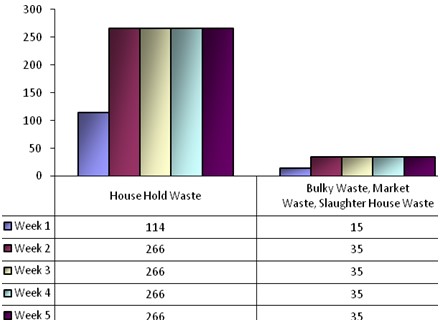
The total number of trips undertaken by lot 5 to facilitate waste collection was 1178 trips for collecting house hold wastes and 155 to the other types of waste. The numbers of trips undertaken were 1333 trips for the month of December 2010. The trips taken towards collecting household costs were more than seven times the trips taken to collect other wastes. The number of trips as evident in lot 2 was constant, such that trips taken the trips taken for collecting house hold wastes were 266 and 35 trips for other wastes. The number of trips to collect the wastes increased during the middle weeks of the month of December again. In addition, this implies that most of the transportation costs were attributed to household waste collection.
General Interpretation
In general, most of the waste collected by the company and lots were composed of the household waste. The highest percentages of trips undertaken were towards their collection. The company in assigning and staff planning should put more emphasis on the number and types of staff assigned to collect house hold wastes. The largest shares of company’s costs are attributable to these wastes and as result house hold costs are the main cash cow or largest source of income to the company. Moreover, the main expenses of the company are transport costs. The largest share of these expense is attributed to Compactor which has evidently been the most preferred vehicle owing to the many trips undertaken using it.
The company should look into the idea of setting up collection points around areas with high tonnages of waste. This will facilitate fast delivery of services to customers and in addition, enhance efficient modes of collecting wastes. The team should use the number of trips to assess the vehicle usage to allocate and in future budget for maintenance, fuel and provisions for depreciation costs for vehicles. It is also worthwhile to note that waste collection is affected by many factors such as location, nature of machinery in use, nature of waste being collected, seasons, the bulkiness or weight of wastes staff allocated and probably distances.
There are also other considerations to take into account while performing waste disposal. These include mode of transport that is if it’s easier and faster to work with, like it is more efficient to work with a Compactor rather than a Hooklift , i.e. waste machineries for transport are specialized to handle certain types of wastes. Finally it is my belief that this analysis will be of benefit in making the team to be in a position to better manage and come up with better strategic plans aimed at making the waste collection effective and efficient.
Note: The above Waste Data is derived from weekly reports submitted by the service providers.